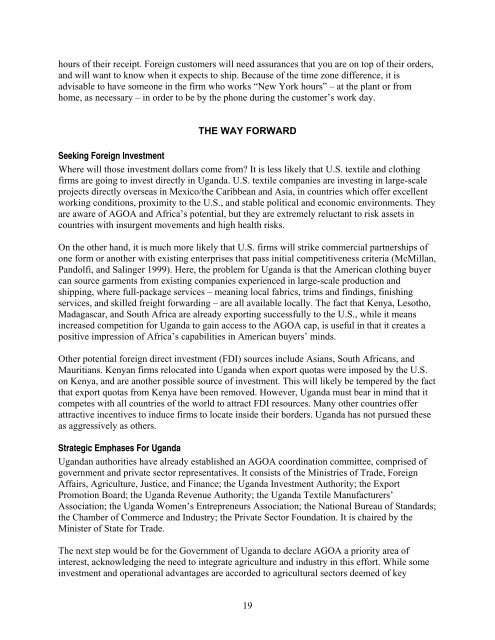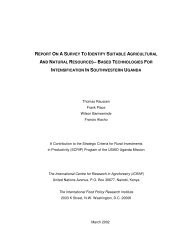Create successful ePaper yourself
Turn your PDF publications into a flip-book with our unique Google optimized e-Paper software.
hours of their receipt. Foreign customers will need assurances that you are on top of their orders,<br />
and will want to know when it expects to ship. Because of the time zone difference, it is<br />
advisable to have someone in the firm who works “New York hours” – at the plant or from<br />
home, as necessary – in order to be by the phone during the customer’s work day.<br />
THE WAY FORWARD<br />
Seeking Foreign Investment<br />
Where will those investment dollars come from? It is less likely that U.S. textile and clothing<br />
firms are going to invest directly in Uganda. U.S. textile companies are investing in large-scale<br />
projects directly overseas in Mexico/the Caribbean and Asia, in countries which offer excellent<br />
working conditions, proximity to the U.S., and stable political and economic environments. They<br />
are aware of AGOA and Africa’s potential, but they are extremely reluctant to risk assets in<br />
countries with insurgent movements and high health risks.<br />
On the other hand, it is much more likely that U.S. firms will strike commercial partnerships of<br />
one form or another with existing enterprises that pass initial competitiveness criteria (McMillan,<br />
Pandolfi, and Salinger 1999). Here, the problem for Uganda is that the American clothing buyer<br />
can source garments from existing companies experienced in large-scale production and<br />
shipping, where full-package services – meaning local fabrics, trims and findings, finishing<br />
services, and skilled freight forwarding – are all available locally. The fact that Kenya, Lesotho,<br />
Madagascar, and South Africa are already exporting successfully to the U.S., while it means<br />
increased competition for Uganda to gain access to the AGOA cap, is useful in that it creates a<br />
positive impression of Africa’s capabilities in American buyers’ minds.<br />
Other potential foreign direct investment (FDI) sources include Asians, South Africans, and<br />
Mauritians. Kenyan firms relocated into Uganda when export quotas were imposed by the U.S.<br />
on Kenya, and are another possible source of investment. This will likely be tempered by the fact<br />
that export quotas from Kenya have been removed. However, Uganda must bear in mind that it<br />
competes with all countries of the world to attract FDI resources. Many other countries offer<br />
attractive incentives to induce firms to locate inside their borders. Uganda has not pursued these<br />
as aggressively as others.<br />
Strategic Emphases For Uganda<br />
Ugandan authorities have already established an AGOA coordination committee, comprised of<br />
government and private sector representatives. It consists of the Ministries of Trade, Foreign<br />
Affairs, Agriculture, Justice, and Finance; the Uganda Investment Authority; the Export<br />
Promotion Board; the Uganda Revenue Authority; the Uganda Textile Manufacturers’<br />
Association; the Uganda Women’s Entrepreneurs Association; the National Bureau of Standards;<br />
the Chamber of Commerce and Industry; the Private Sector Foundation. It is chaired by the<br />
Minister of State for Trade.<br />
The next step would be for the Government of Uganda to declare AGOA a priority area of<br />
interest, acknowledging the need to integrate agriculture and industry in this effort. While some<br />
investment and operational advantages are accorded to agricultural sectors deemed of key<br />
19
















